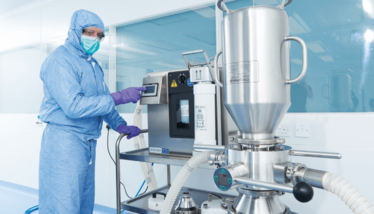
The Value of Valves
Valves are essential in many aspects of pharmaceutical manufacturing, but it’s easy to take them for granted. Ben Wylie from ChargePoint Technology explains the crucial role that valves play in powder transfer – and why attention to detail is important when it comes to making a reliable, fit-for-purpose valve.

This article is part of our special focus on "traditional" pharma: The Small Molecule Manufacturer (read more here). You can find more articles from The Small Manufacturer here.

Meet Ben Wylie
I’m a Senior Product Manager at ChargePoint Technology. I’m responsible for our range of powder containment and aseptic powder handling systems. I help ensure that our solutions meet manufacturers’ needs – now and in the future. I relish working alongside a mix of technical, commercial, management, and service teams to bring the whole jigsaw together. The focus is not only on the development of new products but also making sure existing products continue to do the job! I have been involved in the pharma industry, in various guises, for over 14 years.
What are the main limitations and challenges in powder handling steps?
Barrier technologies, such as isolators and restricted access barrier systems (RABs), provide micro-environments that offer better levels of microbiological protection for a process than traditional open cleanroom environments. The aim is to separate the operator from the product and prevent harmful contamination spreading to critical operations in the drug production process. Many pharmaceutical companies use containment valves integrated to either the isolator or RABS for the transfer of material in or out of the manufacturing process.
Other factors adding to the manufacturing challenge are the increasing use of highly potent active ingredients (HPAPIs), cross contamination that can occur in multi-use facilities, validation requirements in sterile production, and a more fragmented supply chain with the increasing use of contract manufacturing organizations – to name just a few. Ultimately, the market needs more standardized but also more flexible, validated, ready-to-go solutions across the board – including in powder transfer. Single-use technologies generally fit this bill.
Why should the role of valves in containment and powder handling/transfer not be underestimated?
If not managed correctly, sterile manufacturing environments are open to many sources of potential contamination. Contamination risks may come from air filtration systems, materials transfer, and operators (a fully gowned operator may create as many as 150,000 particles per min, many of which are potential hazards during the manufacture of sterile drugs). The need to ensure the safe and sterile transfer of APIs and other formulation ingredients during processing has driven the use of aseptic transfer valves to connect dispensing unit operations to other processes, whilst maintaining sterility assurance. Valves also play an important role in protecting operators and the environment when manufacturing HPAPIs.
Traditionally, it was common for people to do a lot within the process, but manual dispensing, handling, and filling all come with exposure risks, and are also time consuming. Operators can, of course, wear respiratory protective equipment, but the suits are often cumbersome and difficult to operate in! The adoption of a containment valve that fundamentally closes the transfer process mitigates the risk of exposure or contamination, whilst providing a standardized method of solids transfer with a common interface used throughout the plant.
How do your valves work?
Our Split Butterfly Valve (SBV) is a containment valve that allows product to be safely transferred from one container or process vessel to another, while minimizing the levels of dust emission. The concept was originally designed for the contained transfer of APIs, but it’s now suitable for a wide range of applications. Our AseptiSafe bio aseptic SBV enables decontamination to take place in a closed environment. Once sealed, a gap is created between the discs, and vaporized hydrogen peroxide is flushed through the enclosure to decontaminate the space to achieve a 6-log (10-6) sterility assurance of the mating interfaces previously exposed to the clean room environment.
We’ve also paid close attention to cleaning by designing accessory devices for WIP, SIP, and CIP. These accessory devices mimic a standard passive by locking into the active unit to allow it to be opened within a sealed environment. There is no need for a passive unit seat or disc within the device, and this ensures increased efficacy as the surface area of the active unit exposed to the washing or sterilization cycle is maximized versus alternatives that would house an internal seal or disc (providing limited opportunity to clean the critical areas, including the “ring of concern”).
From a powder containment and overall operational performance perspective, it has always been essential to optimize the seat (disc seal) component of the valve – the critical performance-related element in conjunction with the discs themselves. Here, it is important to balance sealing integrity with operability, as well as meeting the basic requirements, such as chemical and temperature compatibility, and ATEX hazardous area ratings. We offer a number of construction materials to meet the varying process variables, but the key detail is that we optimize the seat design during manufacturing to precise tolerances. Such attention to details allows to achieve reliable sealing integrity, as well as operability (and repeatability) in the physical opening and closing of the valve. After all, it’s no good having a really tight seal if the valve is physically difficult to open and close – such stress ultimately causes excessive wear and tear, with consequences in containment performance and the cost of repair.
Finally, particulate extraction has become a vital feature to meet current pharmaceutical manufacturing demands with HPAPIs. Here, our valve coupling design means the passive mates inside the active body to give rise to a chamber that allows effective extraction. After the transfer has taken place, before and during the uncoupling of the valve halves, we extract air from between the separated disc faces (the chamber created) to safely remove any fine particulate residue before it has the chance to become airborne. The system is validated, like all our transfer systems, in line with the ISPE Standardized Measurement of Equipment Particulate Airborne Concentration (SMEPAC) guidelines. And it has also been proven to be effective down to the nanogram levels typically required when handling compounds with operator exposure limits (OELs) of well below <1µg/m3.

You’ve combined your valve technology with single-use packaging…
That’s right. There is a lot of “double handling” in pharmaceutical manufacturing; for example, opening a large drum to take samples and subdivide into smaller volumes for processing increases safety and quality risks. Furthermore, once subdivided, this material then requires an additional handling device, such as a rapid transfer port or SBV, with a rigid or flexible container to control the transfer of material from this dispensing step to the next processing stage. More pharmaceutical companies than ever before are also using multiple manufacturing locations for the development, manufacture, and packaging of products. In short, large amounts of drug products and APIs are being moved between facilities – and between countries. Companies need solutions that facilitate the transition of material.
The ChargePoint Multi-Site Powder Transfer can be used to safely transfer high potency and sterile material – either between process steps or facilities. The solution uses our Single-Use Passive (SUP), a disposable version of the company’s passive mating half of the SBV. The SUP is available with a tri-clamp connection to adapt to existing containers, or can be used in combination with our Chargebag Single Use transfer packaging – made with HIPURE, a pharma-ready LLDPE film. It has excellent mechanical strength and anti-static properties providing both performance and purity for the safety of products and personnel.
Ultimately, this single-use solution eases handling and transport, while reducing the risks of contamination and eliminating the need for cleaning.
What is your advice in terms of care and maintenance of your products to ensure a long life?
As with all consumables, it’s important to ensure comprehensive maintenance is sustained on a regular basis. To help with maintenance, we have actually developed smart monitoring technology (VERIFI) that monitors the operational performance of the valve, providing equipment usage data. It is connected directly onto the ChargePoint Active valve unit and continuously records data and delivers alerts to users. The service advice allows maintenance teams to take preventative action, resulting in less downtime and improved operational efficiency.
What trends will shape the development of future containment solutions for powders?
The industry has seen an influx of new technologies, including single use, in response to specific manufacturing and handling challenges in today’s pharmaceutical operations. At the same time, regulations continue to tighten and the need for flexible manufacturing facilities becomes more prominent. All of these trends will drive development in containment solutions; the industry will have to continue to innovate and adopt new technology to improve manufacturing processes – and to ensure they are fit for the future.



















